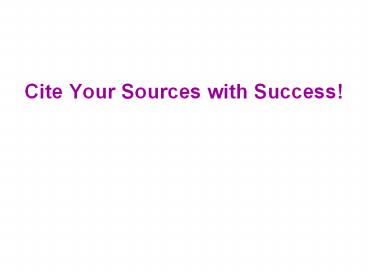Cite Your Sources with Success! - PowerPoint PPT Presentation
Cite Your Sources with Success!
Websters Dictionary. A citation is made of parts. ... The new Grove dictionary of music and musicians (6th ed., Vols. 1-20). London: Macmillan. Reference work ... – PowerPoint PPT presentation
Title: Cite Your Sources with Success!
1
- Cite Your Sources with Success!
2
Why do we cite?
- To find the information cited
- To give credit to the originator
- To avoid plagiarism
3
What is a Style Guide?
- Rules for Citing
- APA or MLA
4
What is Plagiarism?
- "to steal and pass off (the ideas or words of
another) as ones own without crediting the
source." Websters Dictionary
5
A citation is made of parts. Each part shows
specific information about the source of
information.
6
Citation for a Book
Each part shows specific information about the
source of information
- Baddeley, A. D. (1999). Essentials of human
memory. Hove, England Psychology Press.
7
Book Record
Correct way of citing reference Chaplick, D.
(2001). Latin american arts cultures.
Worcester, Mass Davis Publications
8
Reference work like an Encyclopedia or Dictionary
Title of Encyclopedia or dictionary
Editor
Date
Sadie, S. (Ed.). (1980). The new Grove dictionary
of music and musicians (6th ed., Vols. 1-20).
London Macmillan
Place of publication
Edition and volumes
Publisher
9
Article?
- Example
- Walters, T., Quinn, S. R. Walters, L. M.
(2005). Media life among Gen Zeds. International
Journal of Cultural Studies, 8 (1), 63-83.
Retrieved August 23, 2005, from PsycINFO
database.
10
- Article in an Internet-only journal
- Fredrickson, B. L. (2000, March 7). Cultivating
positive emotions to optimize health and
well-being. Prevention Treatment, 3, Article
0001a. Retrieved November 20, 2000, from
http//journals.apa.org/prevention/volume3/pre0030
001a.html - Database used?
11
- Professional web site
- American Psychological Association. (1999, June
1). Electronic preference formats recommended by
the American Psychological Association. Retrieved
July 18, 1999 from the World Wide Web
http//www.apa.org/journals/webref.html
PowerShow.com is a leading presentation sharing website. It has millions of presentations already uploaded and available with 1,000s more being uploaded by its users every day. Whatever your area of interest, here you’ll be able to find and view presentations you’ll love and possibly download. And, best of all, it is completely free and easy to use.
You might even have a presentation you’d like to share with others. If so, just upload it to PowerShow.com. We’ll convert it to an HTML5 slideshow that includes all the media types you’ve already added: audio, video, music, pictures, animations and transition effects. Then you can share it with your target audience as well as PowerShow.com’s millions of monthly visitors. And, again, it’s all free.
About the Developers
PowerShow.com is brought to you by CrystalGraphics, the award-winning developer and market-leading publisher of rich-media enhancement products for presentations. Our product offerings include millions of PowerPoint templates, diagrams, animated 3D characters and more.































